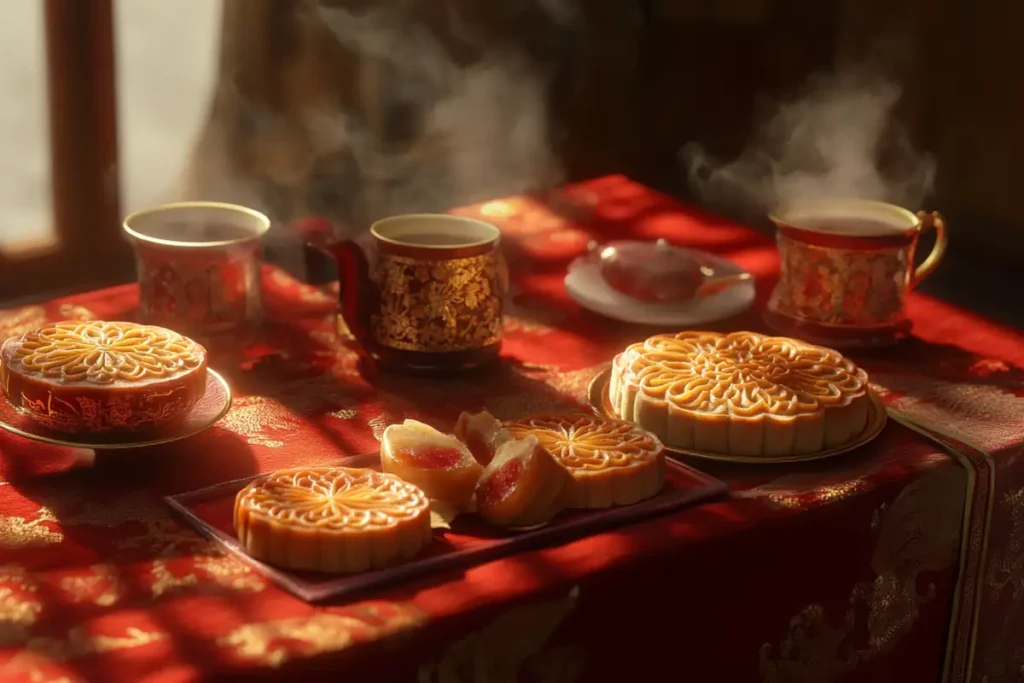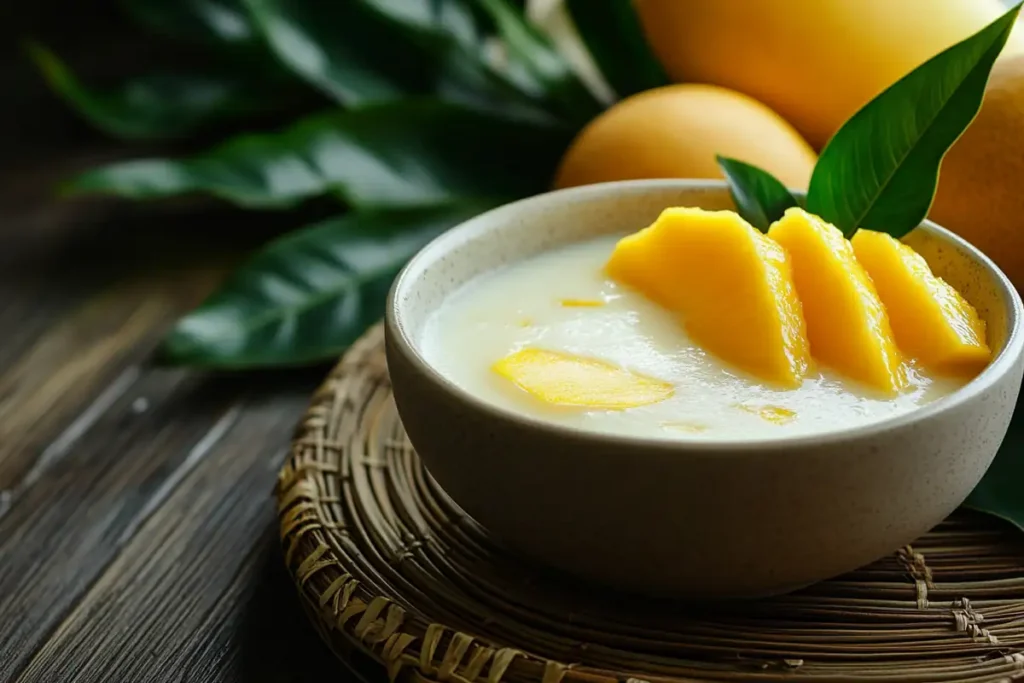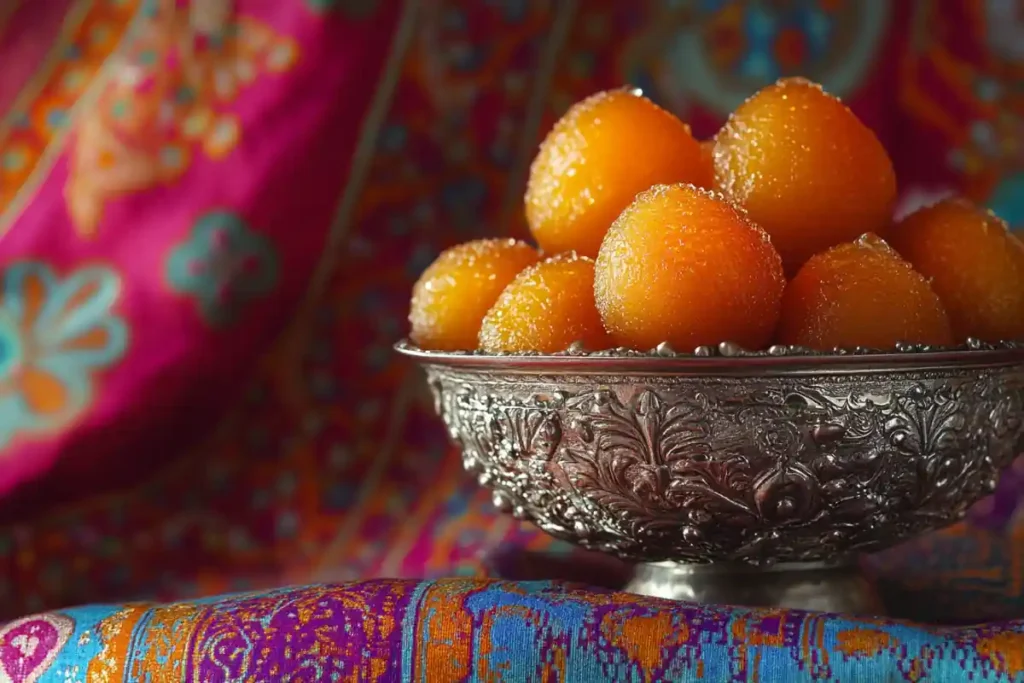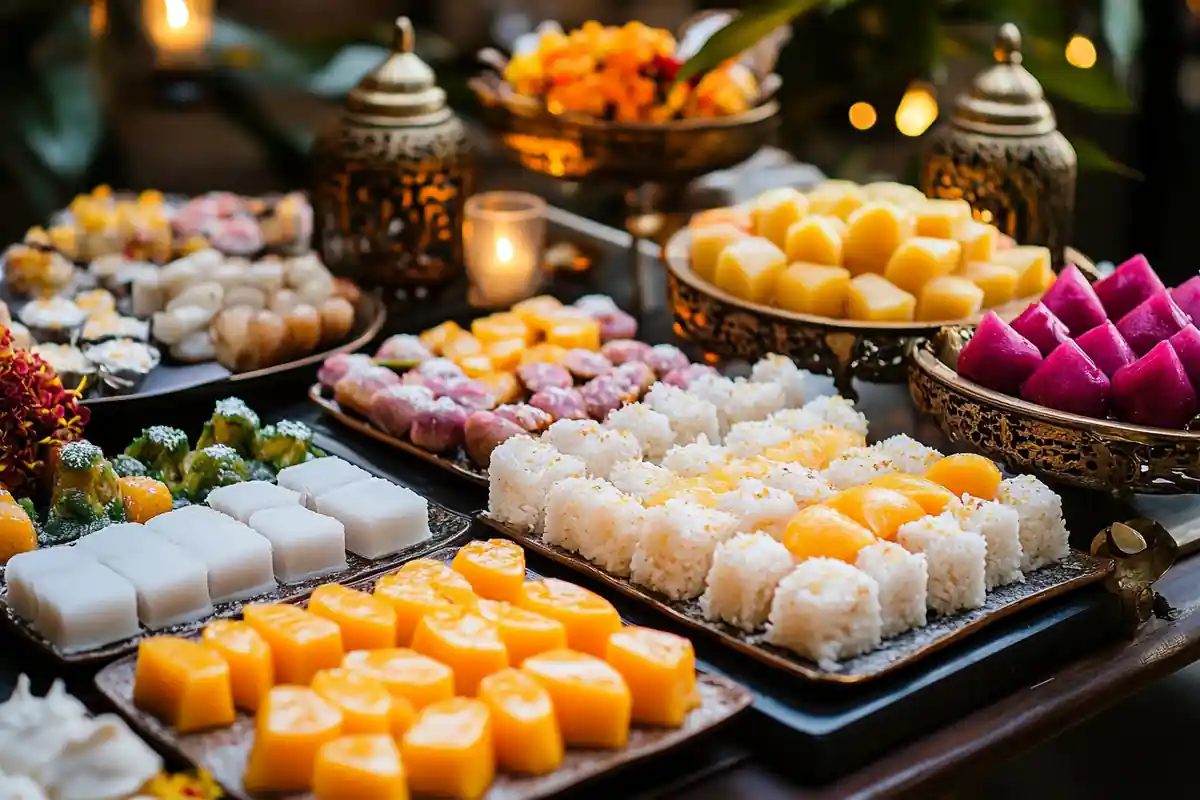Asian desserts deliver a treasure trove of flavors, textures, and cultural significance, captivating anyone who enjoys unique and delicious sweets. For example, the chewy and sweet mochi from Japan showcases simplicity and artistry, while the creamy and luscious gulab jamun from India reflects indulgence and tradition. Additionally, these desserts don’t just satisfy cravings—they bring vibrant culinary traditions directly to your table, offering both taste and meaning.
Whether you crave quick, easy-to-make treats or prefer classic sweets steeped in centuries of history, you’ll find endless options to enjoy. This guide will take you on a journey through the fascinating world of Asian dessert recipes, introducing you to flavors and techniques that will transport you to a world of indulgence and delight.
Exploring the World of Asian Dessert Recipes
Exploring the World of Asian Dessert Recipes
Asian desserts highlight the continent’s incredible diversity by reflecting regional ingredients, culinary techniques, and deeply rooted traditions. For instance, simple home recipes capture everyday comfort, while elaborate festive treats celebrate special occasions with flair. Moreover, these desserts create a harmonious blend of flavors, balancing sweet, savory, and even umami elements to delight the palate.
As their unique tastes and textures continue to enchant food enthusiasts, Asian desserts are gaining well-deserved global recognition. It’s no surprise that these delightful creations are now enjoyed far beyond their places of origin, bringing a taste of Asia to tables worldwide.
What Makes Asian Desserts Unique?
Asian desserts stand out because they use ingredients and presentation in innovative ways. Cooks incorporate rice flour, coconut milk, palm sugar, and matcha to create confections with distinctive tastes and textures. They also balance flavors masterfully—desserts often deliver just the right sweetness paired with contrasting textures, like chewy, creamy, or crunchy.
Traditional Asian desserts frequently connect to festivals and rituals, symbolizing prosperity, happiness, or family unity. For example, families enjoy mooncakes during the Mid-Autumn Festival in China, and people eat tangyuan at the Lantern Festival to invite good luck.
Importance of Desserts in Asian Culinary Traditions
Desserts hold a special place in Asian cultures. They’re not just an afterthought to a meal but an integral part of celebrations and everyday life. Whether it’s the cooling bingsu from Korea, enjoyed during summer, or the steaming hot suji ka halwa relished in winter across South Asia, desserts often tell a story of seasons, history, and heritage.
Overview of Asian Dessert Diversity
Asian desserts showcase an impressive range of flavors and styles. Southeast Asia delivers tropical fruit-based delights like mango sticky rice, while East Asia features refined, artistic sweets such as mochi and dorayaki. South Asia highlights rich, syrupy treats like jalebi and gulab jamun, ensuring there’s something to satisfy every palate.
From the straightforward charm of sesame balls to the intricate layers of nian gao, each dessert invites you to explore the culture it represents. With these sweets’ charm uncovered, let’s dive into the specific regions that shape the diverse landscape of Asian dessert recipes.
Regional Categories of Asian Desserts
East Asian Desserts

Asia’s diversity is most apparent in its desserts, and East Asia is no exception. From the intricate artistry of Japanese wagashi to the indulgent warmth of Korean hotteok, these treats are more than just sweet—they’re an experience.
Popular Chinese Desserts
Chinese desserts are steeped in history and often carry symbolic meanings. Among the favorites:
- Mooncakes: A Festive Treat
Mooncakes are a delicacy often enjoyed during the Mid-Autumn Festival. With a flaky crust and sweet fillings like lotus seed paste or red bean, they symbolize unity and family gatherings. Pairing these with a cup of tea is a timeless tradition. - Tangyuan (Sweet Rice Balls)
People serve tangyuan, glutinous rice balls filled with sesame or peanut paste, in sweet soup. These round, chewy desserts symbolize completeness and are commonly enjoyed during the Lantern Festival to bring happiness and prosperity.
Japanese Desserts
Japanese sweets, or wagashi, feature subtle flavors and artistic presentations.
- Mochi: Traditional Rice Cakes
Mochi, made from glutinous rice pounded into a chewy texture, is versatile. It can be plain, stuffed with sweet fillings like red bean paste, or enjoyed as part of other desserts, such as daifuku or mochi ice cream. - Dorayaki: Sweet Pancakes
Dorayaki is a popular Japanese treat featuring two fluffy pancakes sandwiched with sweet red bean paste. It’s a quick and satisfying dessert that embodies simplicity and tradition.
Korean Desserts
Korean desserts are a mix of refreshing, rich, and heartwarming options.
- Bingsu: Shaved Ice Dessert
Bingsu is a quintessential Korean summer dessert. Topped with condensed milk, red beans, and fruits like strawberries or mangoes, this finely shaved ice treat is perfect for cooling down on a hot day. - Hotteok: Sweet Pancakes
Hotteok is a street food favorite, featuring pancakes stuffed with brown sugar, cinnamon, and chopped nuts. Served warm, it’s an irresistible combination of crispness and gooey sweetness.
Southeast Asian Desserts

Southeast Asia brings tropical flavors to the forefront, making its desserts truly unforgettable.
Thai Desserts
Thai desserts are a celebration of tropical ingredients and vibrant colors.
- Mango Sticky Rice
Mango sticky rice is an iconic Thai dessert, pairing sweet glutinous rice with creamy coconut milk and fresh, juicy mangoes. The balance of flavors and textures makes it a global favorite. - Tub Tim Grob (Red Ruby)
This dessert features crunchy water chestnuts coated in red tapioca flour, served with chilled coconut milk. It’s refreshing, light, and perfect for warm weather.
Vietnamese Desserts
Vietnamese desserts often combine textures and flavors for a unique experience.
- Che Ba Mau (Three-Color Dessert)
A layered dessert of green jelly, red beans, and yellow mung bean paste, served with crushed ice and coconut milk. Che Ba Mau is as delightful to look at as it is to eat. - Banh Flan (Vietnamese Crème Caramel)
Banh Flan combines French inspiration with a Vietnamese twist. This smooth caramel custard gains richness and aroma from coffee or coconut milk.
South Asian Desserts

South Asia offers a decadent array of syrupy and dairy-rich desserts.
Indian Desserts
Indian desserts are a treat for anyone with a sweet tooth.
- Gulab Jamun: Sweet Syrup Dumplings
Gulab jamun consists of deep-fried milk solids soaked in sugar syrup flavored with cardamom or rose water. It’s a must-try at Indian weddings and festivals. - Jalebi: Spiraled Sweet Syrup
Cooks prepare jalebi by deep-frying spirals of batter and soaking them in saffron-infused sugar syrup. Crispy and sweet, it remains a beloved street food dessert.
Pakistani Desserts
Pakistani sweets are rich, comforting, and deeply satisfying.
- Suji Ka Halwa: Semolina Pudding
Suji ka halwa is a velvety pudding made from semolina, ghee, and sugar. Often served with puri bread, it’s a classic breakfast dessert during festive occasions. - Kulfi: Traditional Ice Cream
Kulfi is a dense and creamy frozen dessert flavored with cardamom, pistachios, or saffron. Unlike typical ice cream, it has a distinct, melt-in-your-mouth texture.
Ingredients and Techniques in Asian Dessert Recipes
Essential Ingredients
The charm of Asian dessert recipes lies in their unique ingredients, which bring a burst of flavor, texture, and aroma to every bite. Let’s uncover the magic behind these staples:
Rice and Rice Flour
Rice, in its various forms, serves as the backbone of many Asian desserts. Cooks use glutinous rice to create sticky rice-based sweets, while rice flour provides the foundation for mochi, tangyuan, and rice cakes. Its chewy texture defines several iconic desserts, making it an essential ingredient in Asian cuisine.
Coconut and Coconut Milk
Serves as a cornerstone ingredient in many Southeast Asian desserts, showcasing its remarkable versatility. Coconut milk lends a rich, creamy texture to classics like mango sticky rice, enhancing the dish’s tropical flavor profile. Meanwhile, shredded coconut adds a delightful texture to desserts such as coconut rice cakes, and coconut sugar infuses treats with natural sweetness and a subtle hint of caramel. This multifunctional ingredient brings both depth and balance to a wide variety of Asian dessert recipes.
Sweeteners: Palm Sugar, Jaggery, Honey
Natural sweeteners play a vital role in traditional Asian desserts, offering distinct flavors that complement the other ingredients. Palm sugar and jaggery, both staples in South and Southeast Asian cuisine, provide a deep, earthy sweetness that enhances dishes like gulab jamun and tub tim grob. Their unrefined nature brings a richness that refined sugar simply cannot match. Honey, on the other hand, offers a lighter, subtly floral sweetness and serves as an excellent alternative for those seeking a less intense flavor. Together, these sweeteners define the unique taste of many beloved Asian confections.
Cooking Techniques Unique to Asian Desserts
Preparing Asian desserts showcases skill and creativity, relying on techniques passed down through generations.
- Steaming
Cooks widely use steaming to prepare desserts like Chinese nian gao (sticky rice cake) and Filipino puto (rice cakes). This gentle method ensures even cooking while preserving the ingredients’ delicate flavors. - Frying
Frying creates irresistible textures in desserts like jalebi, sesame balls, and hotteok. These fried treats are often served warm, with crispy exteriors and gooey or chewy centers. - Baking
While not as prevalent as steaming or frying, baking plays a significant role in making mooncakes and banh flan. These desserts often involve intricate designs or layered flavors that highlight the art of baking.
These techniques may seem simple, but they require patience and precision. Mastering them is the key to recreating the authentic taste and texture of traditional Asian desserts.
Easy and Traditional Asian Dessert Recipes
Quick and Easy Asian Desserts
For those short on time but craving the unique flavors of Asian desserts, these recipes are your go-to. They’re simple, delicious, and perfect for beginners!
Recipes Under 30 Minutes
- Sesame Seed Balls
Cooks prepare these crispy treats using glutinous rice flour filled with sweet red bean paste. Once fried, they develop a crunchy exterior with a chewy inside, making them a quick and crowd-pleasing dessert! - Mango Pudding
Mango pudding is a creamy, tropical dessert that requires just a few ingredients: fresh mango puree, gelatin, and a touch of condensed milk. Chill it, and you’ve got a refreshing dessert ready to serve in no time.
Authentic and Traditional Recipes
If you’re in the mood for more elaborate Asian dessert recipes, these traditional favorites bring authentic flavors and rich histories to your kitchen.
Chinese New Year Favorites
- Nian Gao (Sticky Rice Cake)
Nian gao is a steamed cake made from glutinous rice flour and brown sugar. Its chewy texture and sweet, caramelized flavor symbolize prosperity, making it a staple during Chinese New Year celebrations.
Classic Indian Desserts
- Rasgulla: Spongy Cheese Balls
Cooks make rasgulla, a beloved Indian dessert, by boiling soft, spongy cheese balls (chhena) in sugar syrup. Light and juicy, it’s perfect for festive occasions and family gatherings.
Whether you’re after quick treats or time-honored classics, these recipes highlight the diversity and creativity found in Asian desserts. Each dish offers a taste of the region’s rich culinary heritage and guarantees to leave you wanting more.
Modern Twists on Asian Desserts
Fusion Desserts Inspired by Asian Flavors
Modern culinary trends have brought exciting twists to Asian dessert recipes, blending traditional flavors with contemporary techniques and global influences. These fusion desserts offer something new while honoring their roots.
- Matcha Cheesecake
This dessert combines the earthy flavor of Japanese matcha with the creamy richness of classic cheesecake. The vibrant green hue makes it visually striking, while the matcha adds a subtle bitterness that balances the sweetness. - Thai Tea Ice Cream
Thai tea, known for its robust and aromatic flavor, is the perfect base for creamy ice cream. This dessert captures the essence of Thai tea in a cool, refreshing scoop—perfect for summer.
Healthier Variations of Classic Asian Desserts
For those looking to enjoy the flavors of traditional Asian desserts with a healthy twist, these modern adaptations deliver all the satisfaction with fewer calories or specific dietary accommodations.
- Low-Sugar Gulab Jamun
Replacing refined sugar with natural sweeteners like stevia or coconut sugar makes gulab jamun a guilt-free dessert. This creates a lighter version of the syrupy treat without losing its signature taste. - Gluten-Free Mochi
Online specialty shops provide a solution when local options are limited. Many websites catering to Asian cuisine offer delivery for hard-to-find ingredients. Platforms like Amazon and dedicated Asian grocery sites stock essentials such as palm sugar and matcha powder.
These innovative takes on Asian dessert recipes show how versatile and adaptable they can be, ensuring that everyone—regardless of dietary preferences—can enjoy these sweet delights.
Tips for Making Asian Desserts at Home
Where to Source Ingredients
Making authentic Asian dessert recipes starts with sourcing the right ingredients. Here’s where to look:
Local Asian Grocery Stores
Many urban areas feature Asian specialty stores brimming with essentials such as glutinous rice flour, pandan leaves, and coconut milk. These stores often carry fresh, high-quality products ideal for creating authentic Asian dessert recipes. Furthermore, the staff at these stores can be incredibly helpful, so don’t hesitate to ask for recommendations or tips on how to use unfamiliar ingredients. This guidance can make a big difference, especially if you’re new to Asian cooking.
Online Specialty Shops
If finding a local store proves challenging, numerous websites specialize in Asian cuisine and offer delivery of hard-to-find ingredients. Platforms like Amazon and dedicated Asian grocery sites stock a wide range of items, including staples like palm sugar, matcha powder, and even specialized tools. Additionally, shopping online gives you access to customer reviews and product descriptions, which can help ensure you’re purchasing the right items for your desserts. With these resources, sourcing authentic ingredients has never been easier!
Common Challenges and How to Overcome Them
Asian desserts may appear simple at first glance, but many techniques require careful practice and precision to achieve the perfect result. By understanding and addressing common challenges, you can elevate your dessert-making skills and create authentic, delicious treats.
Perfecting Textures
The distinctive textures of Asian desserts—whether it’s the chewiness of mochi or the satisfying crunch of sesame balls—are what make them so special. However, achieving these textures often depends on precise measurements and mastering techniques like kneading dough to the right consistency or frying at the correct temperature. Take your time during these steps, as rushing can lead to uneven results and compromise the dessert’s signature texture.
Balancing Flavors
Asian sweets frequently balance contrasting flavors, such as sweet, savory, and even bitter, creating a uniquely harmonious taste. For beginners, starting with trusted recipes is essential. Gradually adjust sugar levels to suit your preferences, keeping in mind that it’s easier to add sweetness than to reduce it. This method ensures you maintain the intended balance of flavors without overpowering the dish.
Mastering Asian dessert recipes at home is a journey, but with the right ingredients and a little patience, you’ll be creating authentic, mouthwatering desserts in no time.
FAQs About Asian Desserts
What are common Chinese desserts?
Mooncakes, tangyuan, sesame balls, and almond jelly are popular Chinese desserts.
What are the 9 common desserts?
Mochi, mango sticky rice, gulab jamun, sesame balls, bingsu, dorayaki, che ba mau, nian gao, and jalebi.
What is the most famous dessert in Asia?
Mango sticky rice and mochi are among the most iconic Asian desserts.
Who is Catherine Zhang?
Catherine Zhang is a pastry chef known for her Asian-inspired dessert recipes.
Print
Mango Sticky Rice
- Total Time: 40 minutes
- Yield: 4 servings 1x
Description
Mango Sticky Rice is a beloved Thai dessert that beautifully combines creamy, sweet coconut-flavored sticky rice with ripe, juicy mango slices. The subtle sweetness and rich texture of the coconut milk complement the tangy mango, creating a perfect balance of flavors. This easy-to-make dish is a favorite at festivals and a must-try for anyone exploring Asian cuisine.
Ingredients
For the Sticky Rice:
- 1 cup glutinous rice (sticky rice)
- 1 ½ cups water
For the Coconut Sauce:
- 1 cup coconut milk
- ¼ cup granulated sugar
- ¼ teaspoon salt
For the Topping:
- ¼ cup coconut milk
- 1 teaspoon cornstarch
- 1 tablespoon sugar
- ⅛ teaspoon salt
For Serving:
- 1–2 ripe mangoes, peeled and sliced
- Toasted sesame seeds or mung beans (optional)
Instructions
- Prepare the Sticky Rice:
- Rinse the glutinous rice several times until the water runs clear. Soak it in water for at least 4 hours or overnight.
- Drain the rice and steam it in a cheesecloth-lined steamer basket over boiling water for 20–25 minutes, or until tender.
- Make the Coconut Sauce:
- In a small saucepan, combine the coconut milk, sugar, and salt. Heat gently over medium heat, stirring occasionally, until the sugar dissolves. Do not let it boil.
- Once the sticky rice is cooked, transfer it to a large bowl and gradually mix in the coconut sauce. Cover and let it sit for 20–30 minutes to absorb the flavors.
- Prepare the Topping:
- In a small saucepan, whisk together the coconut milk, cornstarch, sugar, and salt. Cook over medium heat, stirring constantly, until the mixture thickens slightly. Remove from heat and set aside.
- Assemble the Dessert:
- Scoop a portion of the coconut sticky rice onto a serving plate.
- Arrange slices of mango beside the rice.
- Drizzle the thickened coconut topping over the rice and sprinkle with toasted sesame seeds or mung beans, if desired.
Notes
- For the best results, use ripe, sweet mangoes like Ataulfo or Haden varieties.
- If glutinous rice is unavailable, substitute with short-grain rice, though the texture will differ slightly.
- Toasted mung beans add a delightful crunch, but they are optional.
- Prep Time: 15 minutes (excluding soaking time)
- Cook Time: 25 minutes
- Category: Dessert
- Method: Steaming
- Cuisine: Thai
Nutrition
- Serving Size: 1 serving
- Calories: 310
- Sugar: 20g
- Sodium: 120mg
- Fat: 10g
- Saturated Fat: 8g
- Unsaturated Fat: 2g
- Trans Fat: 0g
- Carbohydrates: 50g
- Fiber: 2g
- Protein: 4g
- Cholesterol: 0mg
Keywords: Mango Sticky Rice, Thai Dessert, Asian Sweets, Coconut Rice, Tropical Dessert

